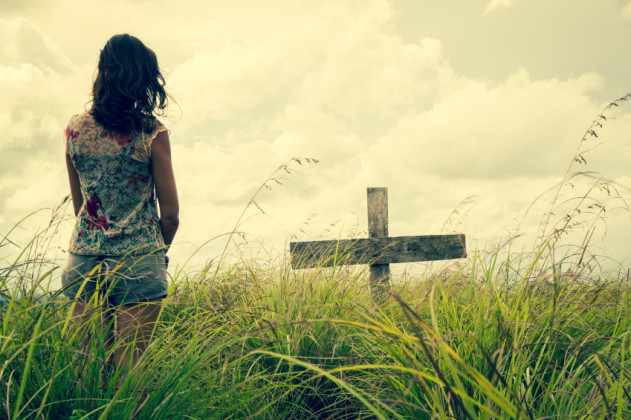She was a beautiful woman, long legs, lovely face, curvy figure—why couldn’t she see it? Why couldn’t she see beauty in me?
My grandmother’s funeral was last week, in a small town in Illinois where a gaggle of sad looking geese huddled together for warmth on a frozen lake in front of a church on a day of subzero temperatures.
During the service, while I was breastfeeding my daughter in the church’s back pew, worried that unsheathing my breasts would be unseemly to many gathered there, I thought about the grief people carry their whole lives, as a result of experience, the body’s many betrayals, the inevitable indignities of age. If you live a long life—and even if you don’t—this holds true. My grandmother lived to be 93, and she had her fair share of grief.
My grandmother was a difficult woman, often moody and mean. She had my father in 1942, when she was just 21 years old, and she didn’t marry the father of her child, a moment of shame that she never truly recovered from. That man was cruel to her, and she went to Chicago to have her baby, away from the small town where she was born and raised. She “came home,” as she put it, and lived her life afraid to take a risk, always afraid to “be wrong,” always afraid of what people thought of her. She never married. She never moved out of state, although she often talked about it. She never visited Paris, although she’d always wanted to go. She never talked much about my grandfather, and my father knew very little about him.
My grandmother was particularly cruel to me, for reasons that mystified me as a child but made more sense as an adult, after I recovered from the initial shock of her treatment and learned to contextualize it. It was from her that I learned to feel shame about my body, a shame I still struggle with.
In 1990, when I was a sophomore in high school, I had just received a mail order J.Crew dress that I bought with money from my job taking catalogue orders for guns and duck decoys and deer drags and camouflage gear at Cabela’s in Kearney, Nebraska, where my family lived at the time. I felt this new acquisition (I remember it was $50, which was more than I’d ever spent on an article of clothing) made the most of my developing curves. It had a mock turtleneck and was made of soft, forest green fabric. It fell to mid-calf and I wore it with my favorite, pointy-toe black flats. As I walked down the stairs in the morning, my grandmother stood at the bottom of the staircase, looking up at me. She looked me up and down. Casually, coolly, she said, “It’s a good thing you’re so smart.”
It was, up to that moment, the most cutting comment I’d ever heard about my body. I knew it was weird, with its clunky wooden leg and awkward gate. I knew I was made differently. And I knew that my grandmother felt I was the physical embodiment of the sin she’d committed with my father’s father, the sex before marriage, the moment she was never forgiven for, the moment she could not forgive herself.
This was the beginning of what felt like a long period of her cruelty to me, one that stopped when I stopped visiting her, which was in 2006. Before that time I had loved going to her apartment in the summer: the grind of the air-conditioner in her living room at night; the sound of the summer bugs at the window; the red velvet cake she made for me; the trips we’d make to the mall; when she brought me with her to court, where she clerked for a judge, and let me organize files. But after that day in 1990, I was a woman, and somehow (I felt) the enemy. I felt dangerous, as if the very fact that I was alive—with a body, with potential—frightened her.
My grandmother never really learned to love, or to be loved. I thought of this as I looked at the box of ashes placed on the platform at the front of the church. Like all of us will be someday, she was reduced to the sum of her remains. Her ashes were interred next to her parents’ at Windtown, a church, literally, in the middle of a prairie. The day was icy and blurry, land and sky flat, meeting on some unseen horizon.
The doxologies and creeds and prayers and “second births” promised by Jesus’s resurrection and earnest songs about Christ’s light didn’t move me. The only time I felt moved was during a very simple song, sung by my dad’s cousin’s husband, a farmer, who stood at the podium and sang a very unornamented “Beautiful Savior,” his voice cracking and swaying and imperfect, but full of emotion.
It was an unsettled moment, a moment with bleeding edges. And questions. Why couldn’t she accept my body, or at least pretend? What was it about women that frightened her? She was a beautiful woman, long legs, lovely face, curvy figure—why couldn’t she see it? Why couldn’t she see beauty in me?
I have a daughter, and I want her to love her body. Perhaps by showing me one way, my grandmother made sure I wouldn’t pass it on. It’s a strange legacy, but it’s one I carry.
Role Reboot regular contributor, Emily Rapp, is a professor in the University of Cailfornia-Riverside Palm Desert MFA program and the author, most recently, of The Still Point of the Turning World.
Related Links:

